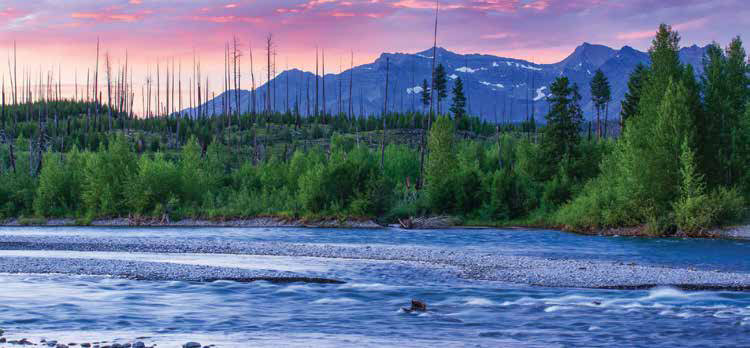
A few days ago, the National Parks Conservation Association released their Summer 2017 Field Report for the Northern Rockies. In it was an article by Michael Jamison, Crown of the Continent Program Manager, that is highly relevant to the North Fork, as well as any other region downstream of the Canadian Rockies. By permission of the author, it is reprinted here in its entirety . . .
People tend to think Glacier National Park is all about mountains.
And people are wrong.
Glacier is also about water: icy cold water rushing clean and clear across gravel and stone; whitewater plunging over cliff-band falls; sky-blue water eddying into lakes set like sapphires into the deep green of wilderness.
From the summit of the park’s Triple Divide Peak, meltwater flows west to the Pacific, east to the Atlantic, north to the Arctic by way of Hudson Bay. Glacier is water tower to a continent, spiked by peaks sharpened on a grindstone of Pleistocene ice.
I recently flew north out of Glacier, over a long slice of Alaska—another place branded by its mountains. Chugach. Wrangell-St. Elias. The Aleutians and Brooks and Chilkats.
But Alaska, like Glacier, is not really about mountains.
What I saw unfolding below was, again, a wild country defined by water: an endless winding coastline; miles of muskeg pooling like quicksilver; rivers washing the feet of mountains, slicing tundra and stone, spilling sediment braids into an ocean the color of steel.
Montana and Alaska are alike in this way. They also share a common headwater: British Columbia.
The Canadian Rockies tumble out of British Columbia into both Montana and Alaska, coursing through wild transboundary rivers. Glacier’s western border is marked by the North Fork Flathead River, which spills south from Canada’s high alpine country. Farther north, Canadian headwaters flow into Alaska’s LeConte Wilderness, by way of the winding Stikine.
These borders matter, even to rivers.
In Glacier’s headwaters, British Columbia’s leadership once planned vast coal mines. We and our partners fought for decades, and in 2011 the province finally banned industry from the watershed that feeds our protected park.
But right next door, in the next valley west, Canadian coal mines still send selenium and other toxins south into Montana’s Kootenai River. It’s the same story in Alaska. Mines old and new and still proposed dot the Canadian maps of the transboundary Taku, Stikine and Unuk rivers.
That’s why I flew up north—to join forces with Alaskan allies, and to confront our common problems in these transboundary watersheds. It’s long since time that British Columbia clean up its paltry process for permitting industry in our headwaters. It’s long since time that the province’s regulations catch up to those of its American neighbors. It’s long since time that waste from old mines be contained, that waste from working mines be treated, and that proposals for new mines be reviewed with a critical eye. It’s long since time, frankly, that downstream stakeholders have a meaningful seat at the Canadian table and a voice for protecting places like Glacier National Park.
So. We’re asking that our Canadian neighbors strengthen their permitting process for industry in our headwaters. We’re asking that they not allow more mines until we first have time to collect baseline science. And most importantly, we’re asking that they designate new parks and protected lands, adjacent to Glacier Park, to offset the loss of mine-impacted habitat.
This is still a new partnership, with Alaska and Montana pressing British Columbia from both north and south. But already the coalition includes state, tribal and federal officials, outfitters and guides, commercial fishermen, scientists, and conservationists – pretty much everyone who drinks from the downstream end of the upstream straw.
Together, we shared some stories, shared some salmon, tracked whales to the mouth of the Taku, and began the long work of reversing the tide. With your help, we will become a powerful current, pressing back against the flow of Canadian industry into these last wild watersheds.